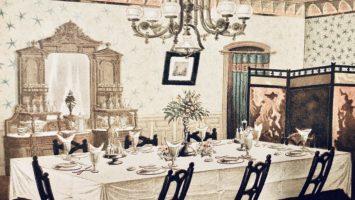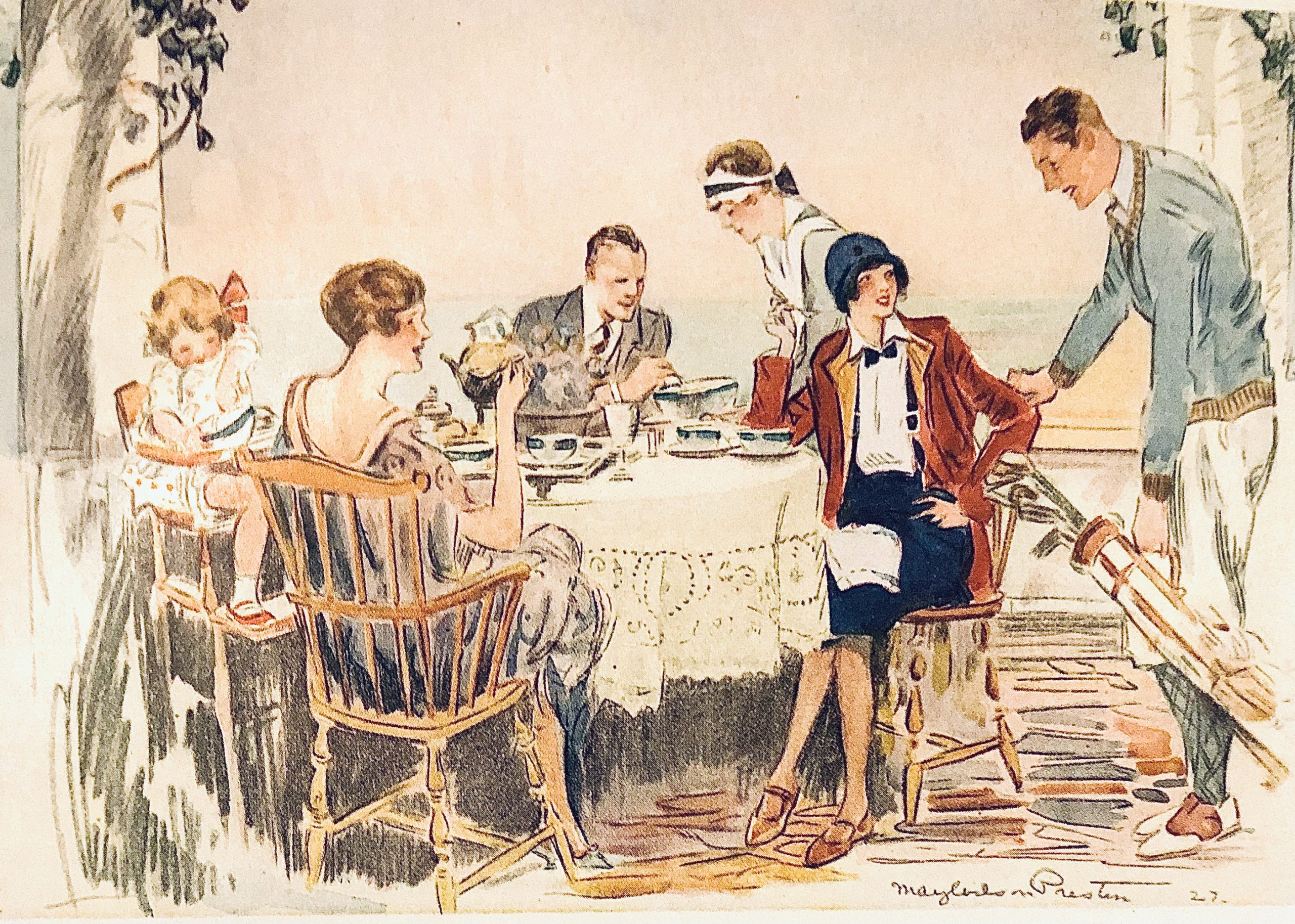Here we have one of those weird evolutions of terms where one phrase begins to mean nearly the opposite thing. High Tea is one of the great examples of this. Company dinner is another. For an American in the early and mid 19th century, a company dinner would have been one of the most extravagant meals they attended. The table would have been laden with the finest china and linen. Three courses would be served, each consisting of not just one item but possibly dozens, depending on the number of guests. A first course could include soup, meat, a half dozen kickshaws/appetizers, sides, and entrees, plus tazzas laden with nuts and sweets. Company dinners were formal affairs with all the strict etiquette included.
As time proceeded and three courses became ten The order of the dishes became separated into an sequential form from light to heavy, savory to sweet. This reached it’s apex in the Edwardian period with every course having it’s own special china and silver.
“To give a successful formal dinner is perhaps he highest test of the social skill and ability of the hostess. It permits her to express her taste and refinement not only in the choice of the all-important menu, but in the details of table setting and service.”
Helps for the Hostess, 1916
Formal dinners are hard, I ain’t gonna lie. It’s the rare bird who wants to throw one, or attend one for that matter. So the multiple courses that used to head northward of ten, are now usually kept to somewhere between five and seven. Some people say that they’re throwing a formal dinner with three or four courses. Four courses are a Soup, Meat, Salad, Dessert. It can also be a Cocktail Appetizer, Salad or Soup, Main and Dessert and some prefer Soup, Fish, Meat and Dessert. Or they might offer up the paltry three course meal, salad or soup, main and dessert as formal. The snobs will sneer at these poor unfortunate souls and I hate to say it, but I agree. Three or four courses is a dinner that can be had in any restaurant or at any wedding. It isn’t formal, even if you make everyone dress up and serve it on fine china. Now don’t @ me, I love dinners of all stripes. I’m just saying that a formal dinner implies more.
Now please don’t mistake me, I’m speaking of the modern formal dinner. The 19th century American formal dinner was an entirely different beast and could include an appetizer, soup, fried course, shellfish or first fish course, game course, second fish course, vegetable course, sorbet, main course, salad course, jelly course, dessert course and finally coffee with confectionary and cookies. This was a culinary mountain that could take four or more hours. Try to remember, no one had HBO to while away the nighttime hours back then, dinner with company was seen as a regular source of entertainment.
As people gained more entertainments in the home, first radio and then television and entertainments outside of the home became less expensive, dinners began to get shorter. This is also owing to the lessening of formality that began with the First World War and went in steep decline during the depression.
“Five courses, in addition to coffee and liqueurs, is almost invariably the maximum served at the most elaborate formal affairs in the most fashionable homes.”
The New American Etiquette, Edited by Lily Haxworth Wallace, 1941
As you can see, by the 40’s the daunting twelve course meal had been reduced to five plus coffee and liqueurs, so technically six courses, (since those were often served with bonbons).
Some etiquette books from the 50’s will mention that formal dinners once were many courses, but currently consist of as little as three. Still, quite a few mid-century etiquette experts were loathe to call this formal, so the term “Company Dinner” was brought back as a descriptor for fancy dinners with fewer courses.
As the home started to be run entirely by the woman of the house, the term shifted again in meaning as it seemed to adequately cover the idea that you might find yourself dressing up, putting out the best china and inviting your boss over for dinner in what would be a high stakes meal, but yet wasn’t quite the long, arduous entertainment that is the formal dinner.
By the fifties, company dinners began to encompass any dressy evening meal in the home, including buffets, that were intended to be servantless or performed with minimal help. In Company Meals and Buffets by Good Housekeeping, there is even a section on table setting that is very reminiscent of a formal dinner, but the word formal is never used and indeed the idea of multiple courses is never introduced.
“Simplicity, not convention makes the rules today. Don’t be afraid to adopt compromises like these when you’re cook and hostess too.”
Company Meals and Buffets by Good Housekeeping, (1958)
So what was once definition of the fanciest of meals, over time became the definition for the pared down way to entertain.
A formal dinner is a long affair with numerous courses. Appetizer, soup, fish, game, meat, salad, dessert, fruit and cheese are the basics. While we might swap out a game course for a something else, the expectation that there would be many numerous courses stays the same. Additionally, formal dinners have strict rules, including the types of tablecloths, lighting, service and dress that depended on the era they were given and that were mostly followed in a rigid fashion. I’ll go into the courses in detail in a later blog post.
An easy rule is if you don’t need help to serve it, it isn’t formal. The minimum a pared down formal dinner can be served with one member of waitstaff, but you’ll also probably need a cook. Unless you’re a chef, timing out multiple courses so that everything is hot when it’s supposed to be and just frozen enough not to be hard, etc. is a daunting task. I love to cook and the two times I attempted a very easy six course meal, (App, Soup, Vegetarian, Fish, Dessert, Fruit & Cheese) I was so run off my feet, I couldn’t really enjoy it. And please note that I served cold appetizers that could be made ahead, same with the dessert and fruit/cheese course) so I was only really serving three main dishes. I made a Victorian formal meal with a helper for my vintage menu club and even with help, it was insanely hard.
Now I’m not saying that I don’t enjoy going over to someone’s house and having a nice three course meal. Most days, I’d prefer it. I’m just saying that I personally like to keep the definitions clear. I’ll be looking at the formal dinner and the company dinner in later posts. Now you know that there is a difference, though you will be in rarified company as one of the few who do.
Quick tip: while this blog is for the people who want to know, other people will think you very annoying if you insist on saying their “formal dinner” wasn’t actually formal, so you might want to keep your superiority to yourself. Much love, Cheri



